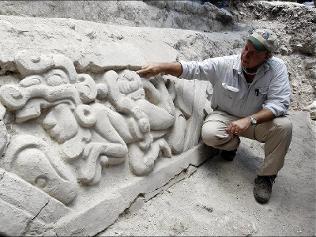
The stucco sculpture, which is more than three metres wide by four metres high, was buried for centuries at the Chilonche ruins, close to the border with Belize.
The recent discovery of the head, which dates from the early Classic period between 300 to 600 AD, means the site is much older than previously thought.
The Maya often constructed new buildings using older ones as foundations.
"It could be an imaginary being, something from the underworld, perhaps linked to a Mayan deity," Polytechnic University of Valencia professor Gaspar Munoz, part of the team of archaeologists that found the head, said.
Unlike Guatemala's famous Mayan cities of Tikal and El Mirador, little excavation has been carried out at Chilonche.
Looters, looking for artifacts to sell on the black market, had dug a small tunnel passing the buried sculpture, which is similar to others decorating a solar observatory at another site, Uaxactun.
Guatemala's Peten region is home to dozens of Mayan ruins, but the largely jungle-covered area is plagued by looters, poachers and smugglers taking cocaine to Mexico.



Reader Comments
to our Newsletter